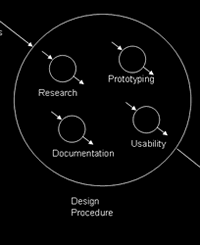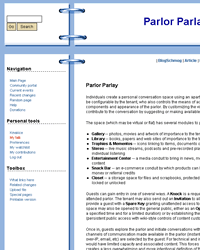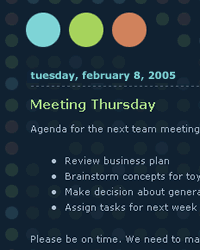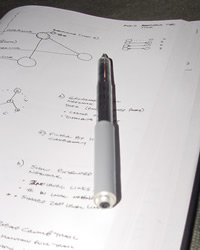mPath Iteration
Good design is redesign. It a process that pauses, but never ends. For mPath, a modified form of Rational Unified Process (RUP) was used during each phase of development to elaborate conceptual ideas. Characterized as a scalable, iterative cycle of four distinct phases, RUP attacks major risks and welcome changes early in the project life cycle. Each component of development — Research, Usability, Interface Design, and Assessment Methodology — follows its own iterative path. RUP strives for a living product that emphasizes stability as the system evolves.
Mutual Politics Project Wiki
Wiki technology has gained traction in recent years, thanks in large part to Wikipedia, the free encyclopedia. Wikis have been very helpful to me in both design research and collaborations. Although this was not a team project, my study of online political forums benefited by being in wiki format because I could easily share data and work-in-progress with others for feedback. I also have a solid body of work that can now be extended into doctoral research. The ability to edit a page in small chunks, as time permits, from any browser has improved my design process and allowed project work to become more pervasive.
Inner Child Project Blog
Communication between our five team members required more than face-to-face meetings. We utilized a linear blog, in addition to a project wiki, to post announcements about meetings, assignment completions, and approaching deadlines. The messages posted to the blog served two purposes. Primarily, this forum was a source of news. It also proved to be a record of our major activity which could be reviewed at the and of the project.
Brainstorm Design Journal
Journaling is an effective way to process ideas. It helps to get thoughts out of one's head and onto a piece of paper. As an idea grows more tangible, vagaries cannot be ignored as easily, and the designer has a record of its development. My design journal for this project is filled with sketches depicting the process of storytelling. Since the charge to our design team included accesibility to those with disabilities (physical and cognitive), the interfaces for each control station had to be clear, concise and inclusive. Several sketches evolve the components and controls needed for this exhibit.
Mutual Politics Design Journal
My design journal for this project is filled with sketches of the process of discussion. I have several iterations, for example, of a prosposed forum system with a focus on conscious decisions to join a bridging or a bonding group to talk politics. Brainstorm journal
The Power of Gangs Feedback & Discussion
As IDEO's Tom Kelley expresses as his company motto: Fail often to succeed sooner. Throughout my exploration of gangs, I met with peers and experts to seek feedback on both the content and the methods in use. The main challenges in this project were access to my user group and heavy constraints on my available time. The former issue radically changed my project at one point from gangs to children, but through discussion with mentors I persisted with my original interest. To have an environment in which such conversations can occur is a valuable asset to a designer. I also benefited greatly by discussing other projects with my peers. Seeing each other fail often led to our collective success.
|
4306 East 10th Street | Bloomington, Indiana 47408 | 812.360.2557 |
k m a k i c e @ i n d i a n a . e d u
|
